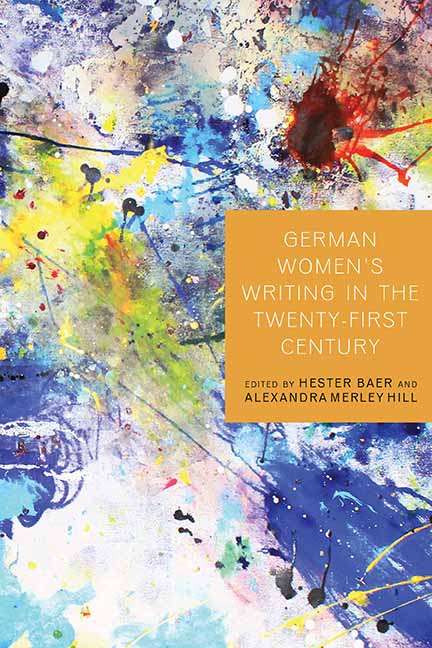Book contents
- Frontmatter
- Dedication
- Contents
- Acknowledgments
- Introduction: German Women’s Writing Beyond the Gender Binary
- 1 Language-Bodies: Interpellation and Gender Transition in Antje Rávic Strubel’s Kältere Schichten der Luft and Judith Hermann’s “Sonja”
- 2 Matrilineal Narrative and the Feminist Family Romance
- 3 The Pitfalls of Constructing a Female Genealogy: Cultural Memory of National Socialism in Recent Family Narratives
- 4 Reckoning with God: Attitudes toward Religion in German-Language Women’s Writing in the Twenty-First Century
- 5 Muslim Writing, Women’s Writing
- 6 Popfeminism, Ethnicity, and Race in Contemporary Germany: Hatice Akyün’s Popfeminist Autobiographic Works Einmal Hans mit scharfer Soße (2005) and Ali zum Dessert (2008)
- 7 The Awkward Politics of Popfeminist Literary Events: Helene Hegemann, Charlotte Roche, and Lady Bitch Ray
- 8 The Indictment of Neoliberalism and Communism in the Novels of Katharina Hacker, Nikola Richter, Judith Schalansky, and Julia Schoch
- 9 Sounds of Silence: Rape and Representation in Juli Zeh’s Bosnian Travelogue
- Bibliography
- Notes on the Contributors
- Index
1 - Language-Bodies: Interpellation and Gender Transition in Antje Rávic Strubel’s Kältere Schichten der Luft and Judith Hermann’s “Sonja”
Published online by Cambridge University Press: 25 May 2021
- Frontmatter
- Dedication
- Contents
- Acknowledgments
- Introduction: German Women’s Writing Beyond the Gender Binary
- 1 Language-Bodies: Interpellation and Gender Transition in Antje Rávic Strubel’s Kältere Schichten der Luft and Judith Hermann’s “Sonja”
- 2 Matrilineal Narrative and the Feminist Family Romance
- 3 The Pitfalls of Constructing a Female Genealogy: Cultural Memory of National Socialism in Recent Family Narratives
- 4 Reckoning with God: Attitudes toward Religion in German-Language Women’s Writing in the Twenty-First Century
- 5 Muslim Writing, Women’s Writing
- 6 Popfeminism, Ethnicity, and Race in Contemporary Germany: Hatice Akyün’s Popfeminist Autobiographic Works Einmal Hans mit scharfer Soße (2005) and Ali zum Dessert (2008)
- 7 The Awkward Politics of Popfeminist Literary Events: Helene Hegemann, Charlotte Roche, and Lady Bitch Ray
- 8 The Indictment of Neoliberalism and Communism in the Novels of Katharina Hacker, Nikola Richter, Judith Schalansky, and Julia Schoch
- 9 Sounds of Silence: Rape and Representation in Juli Zeh’s Bosnian Travelogue
- Bibliography
- Notes on the Contributors
- Index
Summary
UNLIKE ANY OTHER MEDIUM, literature has the ability to employ the reader's imagination in the construction of bodies. When a narrator communicates information about a text's characters, the reader completes the act of constructing bodies by imagining their contours, postures, and gestures. A character's gender is thus dependent upon both the narrator's speech—his/her use of nouns, pronouns, and adjectives—and the reader's expectations regarding gender. If the narrator omits information about the character's gender, the reader finds clues in the text—social cues, behaviors, and actions—to fill in that information and assign one. Such moments activate literature's potential for “undoing” gender and bring to light the ways in which reading literature is an act of collaboration. Through this collaborative process between the reader and the narrator, the reader can become an active participant in the denaturalization of such basic categories as gender.
Two contemporary German authors exemplify literature's ability to employ the reader's imagination in this way. In Antje Rávic Strubel's Kältere Schichten der Luft (Colder Layers of Air, 2007), female protagonist and narrator Anja slowly transforms into a young man named Schmoll after a mysterious young woman (mis)recognizes her as him. Although Anja at first objects, the woman's insistence that Anja is Schmoll leads to Anja's physical and emotional transformation. Anja accepts Schmoll as a second identity within herself, experiencing a plurality of gender whenever Schmoll manifests himself in her body. Judith Hermann's short story “Sonja” (1998) similarly relies on a third party interlocutor to reveal information about the gender of the narrator. The reader may assume a female narrator until, halfway through the story, the protagonist's lover utters the pronoun “er” (he) and thereby forces the reader to reimagine the narrator as a man and her lesbian relationships as his heterosexual ones. Just as in Kältere Schichten der Luft, the gender transition in “Sonja” requires a third party interlocutor within the diegetic world to be initiated in the mind of the reader. In both texts, it is the moment in which heteronormativity is introduced into the lesbian relationship when queering happens—that is, the binary gender system breaks down.
- Type
- Chapter
- Information
- German Women's Writing in the Twenty-First Century , pp. 18 - 36Publisher: Boydell & BrewerPrint publication year: 2015
- 1
- Cited by



